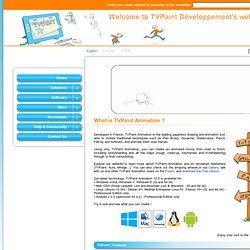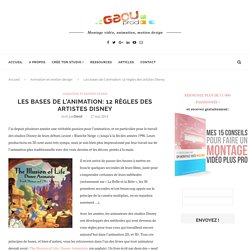

Last Updated: March 30 2016 Quick Links: Download... OpenToonz. Create Animated Videos for your Business. Lessons Worth Sharing. Linuxgraphic.org. Afficher le sujet - Toon boom Studio par un nul ... Les aficionados le savent surement déjà La V7 de Studio est sortie.

Je l'ai téléchargée hier soir. Au-delà de DOFUS et WAKFU, bienvenue dans le KROSMOZ ! Studio. Pencil - a traditional 2D animation software. Developpement - Web Site. Developed in France, TVPaint Animation is the leading paperless drawing and animation tool, able to imitate traditional techniques such as Pen Brush, Gouache, Watercolour, Pencil, Felt-tip and Airbrush, and animate them over frames.

Using only TVPaint Animation, you can create an animated movie from start to finish, including storyboarding and all the steps (rough, clean-up, keyframes and in-betweening) through to final compositing. Explore our website to learn more about TVPaint Animation and its renowned forefathers (TVPaint, Aura, Mirage...). You can also check out the amazing artwork in our Gallery, talk with us and other TVPaint Animation users on the Forum, and download the Trial Version. Try it now and see what you can create ! Enjoy your visit to the TVPaint website ! Want to know the difference between TVPaint Animation Standard and TVPaint Animation Professional ? FREELANCE ANIMATED ACTOR. Studio. Community about the 'Pencil2D', an open-source animation software in development. 11 Documentation. The current project window (or current drawing space) is the one in which you will be able to express your artistic talents and create a wide variety of animated sequences.

In the title bar at the top, the name of the Project, the name of the Clip, the zoom percentage, the the name of the current Layer and the number of the current frame will always be displayed. This window is called a "Timeline" by many users. It is used to manage your notes, your sound tracks, your layers and insert keys for your effects (we will discuss these points in subsequent lessons). If the layer window is not visible on the screen, click on the Timeline icon on the toolbar to make it appear (keyboard shortcut [0] on the numeric pad) In the title bar at the top, the name of the Clip, the name of the current Layer and the frame number will always be displayed. Les bases de l'animation: 12 règles des artistes Disney.
J’ai depuis plusieurs années une véritable passion pour l’animation, et en particulier pour le travail des studios Disney de leurs débuts (avant « Blanche Neige ») jusqu’à la fin des années 1990.

Leurs productions en 3D sont aussi très sympa, mais je suis bien plus impressionné par leur travail sur de l’animation plus traditionnelle avec des vrais dessins et les décors peints à la main. Avec les années, les animateurs des studios Disney ont développés des méthodes qui sont devenus de vrais règles pour tous ceux qui travaillent encore aujourd’hui dans l’animation 2D, et 3D. Tous ces principes de bases, et bien d’autres, vous les retrouverez dans l’un des livres que tout animateur devrait avoir: The Illusion of Life: Disney Animation. The Animator´s Checklist. Bonjour à tous, Lorsque j'ai voulu écrire des articles sur les différentes étapes du Worflow, je me suis rendu compte que je ne pouvais commencer sans parler de la pierre angulaire de l'animation : La pose.

Récemment je discutais avec un ancien élève qui me racontais que la plupart des "retakes" qu'il recevait se trouvait dans son posing. Voici donc une liste des différentes étapes afin de créer une pose claire et solide. Avant tout, il est conseillé de travailler de l'intérieur vers l'extérieur:1. 2. Préparer le set et placer le root du personnage et des objets en place dans la scène. Definissez à travers du bassin et le torse l'intention du personnage. • Power Center : Definissez d'ou provient son énergie. • Force : Definissez qu'elles sont les forces externes et internes de la pose. • Line of Action : Dessinez une ligne passant par le corps définissant son attitude. Caricaturez la pose. • Caricature : Exagèrez les concepts de votre pose. Toonz Software Used by Studio Ghibli and 'Futurama' Being Made Free and Open Source.
Atsushi Okui, executive imaging director at Studio Ghibli, explained that they initially chose Toonz back in 1995 “in order to continue producing theater-quality animation without additional stress,” and a desire for software that had “the ability to combine the hand-drawn animation with the digitally painted ones seamlessly.”

However, Toonz is not exclusive to Ghibli and is used by plenty of other studios, including Rough Draft, which produced Matt Groening’s Futurama with it, and Folimage, which used it for its recent feature, Phantom Boy. The software boasts an extensive history, dating back to 1993, and has been used on the production of many Hollywood features and TV series including Fox’s Anastasia, Amblimation’s Balto, and MTV’s The Maxx, as well as popular computer games like Psygnosis’s Discworld 2. It was originally available only for high-end SGI workstations, and for a period of time was part of Microsoft’s Softimage arm, which later became Autodesk.